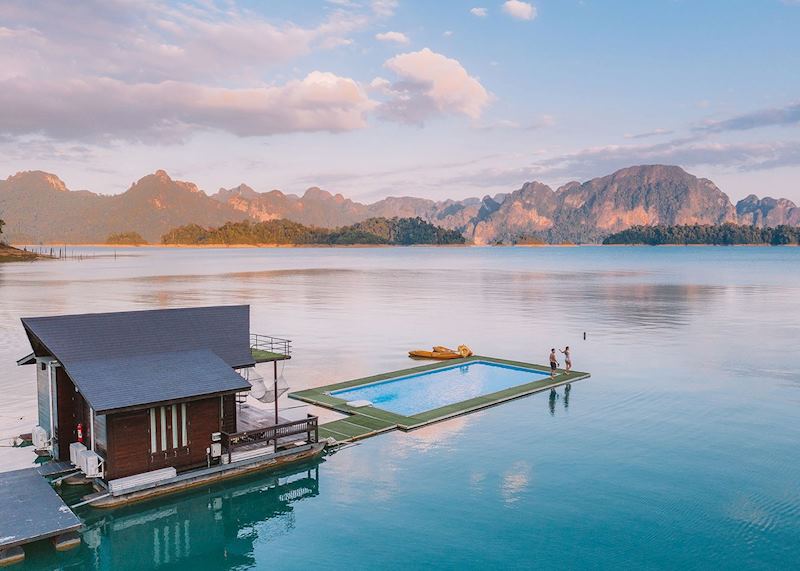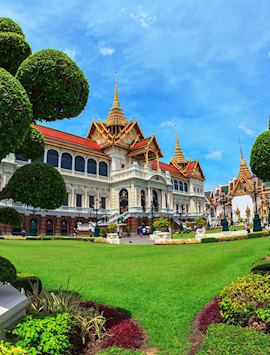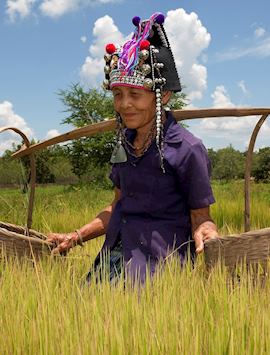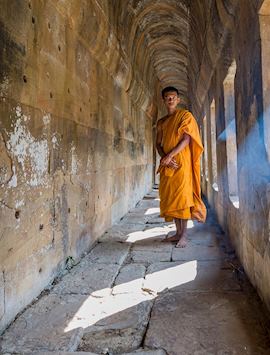By Southeast Asia specialist Dom
Bangkok’s neon-lit streets and Phuket’s white-sand beaches are often the first images that pop into people’s minds when they think of a trip to Thailand, but there’s so much more to uncover if you venture beyond the well-trodden paths. There are still corners of the country that remind me of the Thailand I first visited almost 20 years ago, before it became the must-see destination it is today.
From meeting members of the traditional Black Lahu community near Pai to spotting wild elephants in Kui Buri, going off the beaten track helps you sidetrack the less authentic veneers you might find in some of the more popular areas. It often requires more effort to get there, and the stays are sometimes simpler, but I think it’s well worth it to connect with Thailand’s true character, away from the crowds.
Wildlife in Khao Yai National Park & Kui Buri National Park
Thailand has become synonymous with elephants, but most people only get the chance to see them in captivity (and only a select few sanctuaries live up to our ethical standards). But for a wild elephant experience, you’ll need to travel a little further.
Khao Yai National Park is slowly becoming more popular, but you can still see wild elephants here, if you’re lucky. For your best chances, opt for a 4x4 night safari from December to February — they sometimes step right out in front of your path. But even if you don’t see any, there’s plenty of other wildlife to spot on guided treks into the forest, including gibbons, hornbills, and pit vipers. Also, look out for elephant tracks and bear-claw marks as you go — a sign that they’re here even if you don’t physically see them.
For an unexpected place to stay in Khao Yai, I love the InterContinental. Designed by architect Bill Bensley, each of the rooms, suites, and villas is crafted to look like a vintage railway car — a journey in itself.
Kui Buri is another national park I recommend for elephant spotting, and while they’re much easier to come across here, it’s a very intrepid experience. In the soaring temperatures of May, the foliage dies down significantly, lifting the leafy curtain that elephants otherwise hide behind. While not completely guaranteed, sightings are very common at this time, and you’re unlikely to come across many other people.
With simple lodges and open-air 4x4s, Kui Buri is as close as Thailand gets to traditional safaris. You’ll start your day with a local family, swapping stories over lunch in their home. With your private guide as a translator, they’ll tell you about the local rubber and pineapple trades, the village’s main source of income, before you set off for the park. As you follow the track, keep your eyes peeled for tell-tale signs of dung and snapped tree branches that lead the way to wide-open clearings where you’re most likely to see what you came for: herds of elephants grazing, marching, and lazing in the sun.

Outdoor adventure in Khao Sok National Park
While Khao Sok National Park itself is far from “undiscovered”, there are corners you can escape to without the swells of visitors found in the village and nearby park entrance. Staying at 500 Rai Floating Resort is my preferred way to see the wilderness from a fresh perspective.
Reached only by boat, the resort rests on the mirror-calm teal waters of Cheow Larn Lake within the national park. Each room has a private balcony, with uninterrupted views of the forested karst peaks in the distance, and you’ll have a personal kayak to explore the lake at your own pace. As you paddle, you might spy the monkeys that live nearby, too.
During your stay, you can take part in an array of experiences within the national park, from longtail boat rides that take you further into the lake to jungle treks that lead you to caves hidden within limestone karsts. You’ll be accompanied by expert guides who’ll share their wisdom on the park’s fauna and flora. Among the wildlife you might spot along the shore are buffaloes, hornbills, and even elephants.

Culture in Northern Thailand: Chiang Mai & beyond
Aside from Bangkok, Chiang Mai is one of the country’s best-known destinations for culture. Once the capital of the Lanna Kingdom, its streets are still filled with gilded temples and markets shrouded in the aromatic steam of street food. While this can’t be considered off the beaten track, it is a good base for exploring the more remote regions of northern Thailand — and there’s one route that neatly ties them together.
The Mae Hong Son Loop is a scenic road trip that takes you from the city up into the hills of Mae Hong Son, close to the Myanmar border, across to the mountain villages near Pai, and back down to Chiang Mai. As your driver-guide navigates the winding route, you can take in the emerald scenery of Thailand’s rural north, pausing at viewpoints to gaze out at seas of mossy-looking hills overlapping into the horizon.
Throughout your journey, you’ll pass by small towns, villages, rice paddies, and farmland that give you an insight into life here, but for a deeper understanding, I can arrange for you to visit a Black Lahu village near Mae Hong Son. The Black Lahu people, one of Thailand’s hill tribe communities, originally lived in southern China before migrating to the northern hills of Thailand. They still uphold traditions passed down from their ancestors and make a living from agriculture and pig farming.
After a trek across undulating, forested terrain (with a stop for lunch cooked over a bamboo fire), you’ll be welcomed into the village by members of the Black Lahu community, together with a guide who can translate for you. Inside one of their stilted homes, you’ll learn about the traditional black robes that the group are named after, their bamboo weaving techniques, and Lahu instruments that are played during important festivities like the Lahu New Year.

Beach relaxation in Khanom, Koh Lipe & Koh Phra Thong
White-sand beaches are a big draw for many people visiting Thailand, so it’s not surprising that large swathes of its coastlines get busy. Yet, some stretches of sand remain pleasingly peaceful. My top three beach destinations are Khanom, Koh Lipe, and Koh Phra Thong, each with its own distinct personality.
With forested hiking trails, cave complexes, and waters home to rare pink dolphins, Khanom is my recommendation if you want somewhere to relax and explore in equal measure. This quiet fishing town is located on the southeastern coast of Thailand, about a 90-minute drive from Surat Thani Airport, which is, in turn, a short flight from Bangkok. The beach here is secluded, often used by a handful of guests and local fishermen. Another benefit of steering away from the crowds is the food — in Khanom, you’ll taste bolder, more authentic flavours because the cuisine is made almost exclusively for Thai palettes.
If you’d prefer an island stay, opt for Koh Lipe or Koh Phra Thong instead. Koh Lipe is so tiny that you can walk to the other side in just 30 minutes. When you’re not unwinding on cliff-framed sands, swimming in the calm waters, or snorkeling among the corals (and sea turtles), you can sample street food at the nearby market or take a boat trip to the surrounding islands for a picnic on even more secluded shores. There also are some nearby jungle trails to enjoy, but I suggest taking a boat to Koh Adang, which has trails leading to hidden waterfalls and viewpoints that give you a chance to see Koh Lipe from above.
Koh Phra Thong, on the other hand, is a “get away from it all” kind of beach destination. There’s not much to do here other than relax, but that’s entirely the point. You’ll stay in a beachfront villa, where you can slow down with daily yoga or meditation, sink into a Thai massage at the spa, or simply roll out a towel on the empty white sand and soak up the hush.

Getting off the beaten track in Bangkok
Almost every Thailand trip starts in Bangkok, so I won’t pretend that it’s off the beaten track in the slightest. However, there are ways to explore the city that most visitors are none the wiser about.
One place I consider to be underrated is Talat Noi, a historic quarter that overlaps somewhat with Chinatown. It’s often called the street art capital of Bangkok due to the many murals that adorn its buildings, and you can spend a while getting lost in its side streets searching for them.
During my own stroll here, I found Mother Roaster, a quirky coffee shop that looked more like someone’s house than a cafe, with a dark-wood balcony adorned with hanging plants. Located above a car parts workshop (common in this area), it’s a little hard to find, but the aroma of freshly ground coffee and the neon-bright cartoon mural at its entrance soon lured me in.
Talat Noi is gaining traction, so I don’t think it’ll fly under the radar for much longer. If you do want a little more peace, I can arrange for a guide to take you on a longtail boat into Bangkok’s less-visited klongs (canals). Lined with stilted teak houses interspersed with palm trees, the narrow waterways offer a glimpse into a slower paced way of life in the capital as people relax and work on their porches and return from the market in wooden rowboats — a side of the city many other visitors miss.






